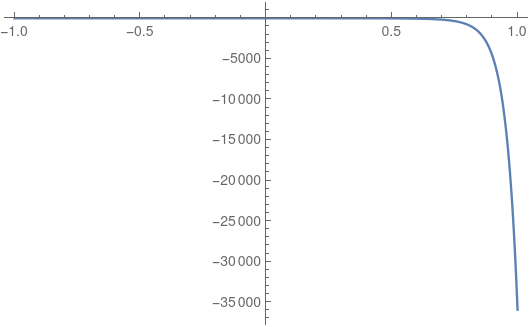I am trying to solve numerically the following set of differential equations
eqs = {
D L^2 c'[y] - L my[y] == 0,
D L^2 my''[y] - L (Qyy'[y] + c'[y]/3) - my[y] == 0,
D L^2 Qyy''[y] - (4/15) L my'[y] - Qyy[y] == 0,
c[-1] - L my[-1] - 1/(3 D) == 0,
D L^2 my'[-1] - L (Qyy[-1] + (1 + c[-1])/3) == 0,
D L^2 my'[1] - L (Qyy[1] + (1 + c[1])/3) == 0,
D L^2 Qyy'[-1] - (4/15) L my[-1] == 0,
D L^2 Qyy'[1] - (4/15) L my[1] == 0
}
What I am actually interested is the solution to above set of equations for the parameters D and L being from the interval (0,1). For not too small values of D, and L, one can just simply use NDSolve without any further problems to obtain an accurate solution.
For small values of D and L, for example D = 1/2, and L = 1/10, the solution is very stiff close to the boundaries y = - 1, and 1, so that the solution is problematic
pars = {D -> 1/2, L -> 1/10};
sol = NDSolve[eqs /. pars, {c, my, Qyy}, {y, -1, 1}];
Plot[c[y] /. sol, {y, -1, 1}, PlotRange -> All]
NDSolve::bvluc: The equations derived from the boundary conditions are numerically ill-conditioned. The boundary conditions may not be sufficient to uniquely define a solution. If a solution is computed, it may match the boundary conditions poorly.
NDSolve::berr: The scaled boundary value residual error of 2.9891304910534367`*^10 indicates that the boundary values are not satisfied to specified tolerances. Returning the best solution found.
First approach
My first idea was to solve this problem using StiffnessSwitching method, but this does not automatically solve the problem
pars = {D -> 1/2, L -> 1/10};
sol = NDSolve[eqs /. pars, {c, my, Qyy}, {y, -1, 1},
Method -> "StiffnessSwitching"];
Plot[c[y] /. sol, {y, -1, 1}, PlotRange -> All]
NDSolve::bvluc: The equations derived from the boundary conditions are numerically ill-conditioned. The boundary conditions may not be sufficient to uniquely define a solution. If a solution is computed, it may match the boundary conditions poorly.
NDSolve::berr: The scaled boundary value residual error of 1.631995982197461`*^8 indicates that the boundary values are not satisfied to specified tolerances. Returning the best solution found.
I assume the problem is related to the mesh that StiffnessSwitching method is using. I could in principle set MaxStepSize -> 0.001, but I guess this makes the whole StiffnessSwitching method useless if the MaxStepSize is smaller than the step size used in StiffnessSwitching. Is there a different way of approaching this problem? Is there a way of telling mathematica to use a finer mesh, but to preserve the uneven distribution of points convenient for dealing with stiff functions?
Second approach
I also tried to solve this problem using spectral methods. If I understand the documentation correctly (https://reference.wolfram.com/language/tutorial/NDSolveMethodOfLines.html) the following code should solve the equations on the Chebyshev grid, but the result does not seem to differ from the original approach that was done without specifying any Method at all
pars = {D -> 1/2, L -> 1/10};
points = 80;
sol = NDSolve[eqs /. pars, {c, my, Qyy}, {y, -1, 1},
Method -> {"MethodOfLines",
"SpatialDiscretization" -> {"TensorProductGrid",
"DifferenceOrder" -> "Pseudospectral", "MaxPoints" -> points,
"MinPoints" -> points}}];
Plot[c[y] /. sol, {y, -1, 1}, PlotRange -> All]
NDSolve::bvluc: The equations derived from the boundary conditions are numerically ill-conditioned. The boundary conditions may not be sufficient to uniquely define a solution. If a solution is computed, it may match the boundary conditions poorly.
NDSolve::berr: The scaled boundary value residual error of 2.9891304910534367`*^10 indicates that the boundary values are not satisfied to specified tolerances. Returning the best solution found.
Is there something I am missing in here? Even varying the number of points does not seem to have any effect on the result.





Dthat are protected system commands. $\endgroup$WorkingPrecision -> 32. Raising working precision is the rich person's solution to bad conditioning. You might also addPrecisionGoal -> 8to keep the precision goal the same. It generally will be set to half the working precision. Raising the precision goal tends to make the conditioning seem worse, but the practical reason is that you probably don't need a more precise result. $\endgroup$WorkingPrecision -> 100, PrecisionGoal -> 8worked for me in that case. It does suggest it may keep getting more difficult as D approaches zero. $\endgroup$